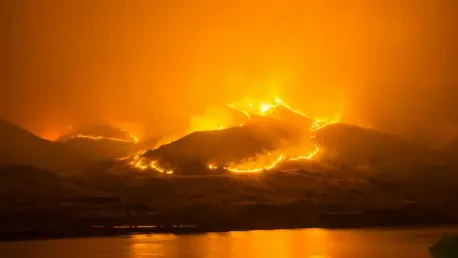In the heart of California, where wildfires have become a relentless scourge, communities face not only the destruction of homes and landscapes but also a complex financial battle playing out behind the scenes. Hedge funds and alternative investment managers have been capitalizing on this crisis by speculating on wildfire insurance claims through a process known as subrogation, purchasing claims at a discount from insurers and betting on substantial payouts by suing utilities like Pacific Gas & Electric Corp. (PG&E). This practice, while offering a mechanism for insurers to mitigate risk, has ignited fierce debate about the ethics of profiting from disaster. As damages from recent fires in areas like Los Angeles soar into the tens of billions, the state has stepped in with a groundbreaking response to rein in what many see as opportunistic behavior, setting the stage for a clash between financial interests and public welfare.
Legislative Pushback Against Speculation
Safeguarding the State’s Wildfire Fund
A significant turning point came in September 2023 when Governor Gavin Newsom signed a new law designed to curb the speculative activities of hedge funds in wildfire insurance claims. This legislation, embedded within a broader initiative to bolster wildfire prevention and funding, targets the practice of subrogation where investors buy claims at reduced rates and pursue legal action against utilities for potentially massive returns. The California Wildfire Fund, established in 2019 as a critical safety net for fire-related liabilities, has been under increasing strain due to the escalating frequency and severity of wildfires. Critics, including the California Earthquake Authority (CEA), have decried hedge fund involvement as exploitative, arguing that such financial maneuvers drain resources meant to protect and rebuild devastated communities. This new legal framework aims to prioritize public interest by introducing barriers that could significantly alter how these claims are handled in the market.
Beyond the ethical concerns, the specifics of the legislation create tangible hurdles for hedge funds looking to profit from subrogation claims. One key provision grants utilities the right of first refusal, allowing companies like PG&E and Southern California Edison to match any settlement offer made by investors, potentially sidelining hedge funds from lucrative deals. Additionally, a non-disclosure clause obscures pricing details, injecting uncertainty into the market and making these investments less appealing. Legal experts suggest that such measures will likely shrink the market for subrogated claims as the added risks deter speculative activity. The intent behind these changes is clear: to shield the California Wildfire Fund from being undermined by private gain. This move reflects a broader commitment to ensuring that financial mechanisms do not exacerbate the challenges faced by a state already grappling with natural disasters of unprecedented scale.
Voices of Concern and Support
The backlash against hedge fund speculation has been amplified by stakeholder groups who view the practice as a moral failing during a time of crisis. Organizations like The Utility Reform Network have been vocal in their criticism, emphasizing that wildfires are not just financial opportunities but human tragedies that demand a collective, supportive response. The CEA has similarly labeled these investments as opportunistic and profit-driven, highlighting the disconnect between private motives and public needs. Their stance underscores a growing sentiment that disaster recovery funds should not be siphoned off by speculative ventures. This perspective has found resonance among policymakers who crafted the new law as a protective measure, aiming to redirect focus toward sustainable recovery rather than short-term financial windfalls for a select few investors.
Support for the legislation extends to major utilities as well, with companies like PG&E and Southern California Edison issuing statements welcoming the changes. They argue that the law strengthens the wildfire fund by limiting external speculation that could destabilize the financial mechanisms designed to address fire-related damages. This alignment between advocacy groups and utilities illustrates a rare consensus on the need to prioritize long-term stability over immediate market gains. However, not all reactions are uniformly positive, as some industry observers worry about unintended consequences. The tension between safeguarding public resources and maintaining a functional insurance market remains a central point of contention, reflecting the complex interplay of ethics and economics in disaster response strategies.
Financial Stakes and Ethical Concerns
High Profits and Public Outcry
The financial allure of subrogation claims has drawn significant attention from hedge funds, with entities like Baupost Group LLC reportedly earning around $1 billion from claims against PG&E in a single year. This profitability stems from a straightforward strategy: purchasing claims at a discount from insurers eager to avoid the uncertainties of prolonged litigation, then pursuing legal action against utilities often held liable for wildfire damages due to equipment failures or negligence. The potential for outsized returns has made this a lucrative niche for alternative investment managers, turning natural disasters into high-stakes financial bets. Yet, this practice operates in a gray area of morality, as the funds reaped from such deals often come at the expense of communities already reeling from loss, raising questions about the appropriateness of capitalizing on widespread suffering.
Public outcry against this speculative activity has been sharp and sustained, driven by advocacy groups and affected residents who see it as an exploitation of tragedy. The notion of hedge funds profiting while families rebuild their lives strikes a deep chord of resentment, fueling calls for stricter oversight. Ratepayer advocacy organizations argue that every dollar diverted to investors is a dollar less for recovery efforts or preventive measures against future fires. This sentiment has gained traction among California’s policymakers, who face mounting pressure to address the ethical implications of disaster profiteering. The emotional weight of wildfires, compounded by their increasing destructiveness, has transformed this financial issue into a broader debate about societal values and the role of private capital in public crises, pushing the state to act decisively with regulatory measures.
Market Stability or Moral Failing
Hedge funds defend their involvement by asserting that their role injects much-needed liquidity into the insurance market, allowing insurers to transfer risk and maintain operational stability. By taking on the burden of litigation, these investors argue they enable insurers to free up capital that can be redirected to other pressing needs, such as covering immediate claims or investing in risk mitigation. High-profile transactions, with claims tied to recent fires surpassing $1 billion, underscore the scale and significance of this market. From this perspective, subrogation deals are not merely speculative but a critical component of a functioning insurance ecosystem, providing a buffer against the financial shocks of natural disasters that threaten to overwhelm traditional mechanisms.
However, this argument struggles to resonate against the backdrop of California’s wildfire crisis, where the human toll often overshadows economic rationale. The perception of hedge funds as vultures circling over disaster-stricken areas has fueled a narrative of moral failing, with critics contending that no amount of market stability justifies profiting from calamity. This ethical divide has deepened as wildfire damages continue to escalate, placing additional strain on public resources like the California Wildfire Fund. The clash between the pragmatic benefits of financial innovation and the visceral reaction to perceived exploitation remains unresolved, highlighting a fundamental challenge in aligning market dynamics with social responsibility during times of widespread hardship.
Market Impacts and Future Uncertainties
Navigating Reduced Liquidity Risks
The introduction of California’s new law has sparked a spectrum of opinions regarding its potential impact on the insurance market, with some experts cautioning against a reduction in liquidity. By imposing barriers like the right of first refusal for utilities and non-disclosure requirements, the legislation could deter hedge funds from participating in subrogation deals, thereby limiting the avenues through which insurers offload risk. This shift might force insurers to retain more liability on their books, potentially leading to higher premiums or reduced capacity to cover claims. Industry analysts note that while the intent is to protect public funds, the ripple effects could inadvertently burden consumers and smaller insurance providers, who rely on such transactions to manage their exposure to catastrophic losses in an era of intensifying natural disasters.
Further complicating the outlook is the temporary nature of some impacts, as suggested by certain industry voices. A delay in claim sales—potentially as short as 30 days due to utilities’ frequent inability to settle quickly—might still erode profitability for hedge funds, prompting a reevaluation of their strategies. This short-term hiccup could push insurers to explore alternative risk transfer mechanisms, though such options may come with their own set of challenges and costs. The uncertainty surrounding these market adjustments underscores a broader concern: striking a balance between curbing speculative excess and preserving the financial tools necessary to address wildfire liabilities. As the state navigates this delicate terrain, the insurance sector braces for a period of adaptation that could redefine how risk is managed in the face of recurring environmental crises.
Long-Term Implications and Equitable Solutions
Looking ahead, the long-term consequences of restricting hedge fund involvement in wildfire claims remain a subject of intense speculation among analysts and stakeholders. The California Wildfire Fund, with its claims-paying capacity poised to expand by $18 billion through customer bills and utility contributions, stands as a cornerstone of the state’s disaster response framework. Protecting this resource from speculative drain is a key objective of the new law, yet questions persist about whether reduced investor participation might lead to higher costs for insurers, which could ultimately trickle down to policyholders. The potential for increased financial pressure on consumers highlights the need for careful monitoring as these policies unfold, ensuring that protective measures do not inadvertently exacerbate economic disparities.
Equally pressing is the search for fairer solutions to wildfire liabilities that prioritize community recovery over market gains. The legislation marks a critical step in reasserting public welfare over unchecked financial speculation, reflecting a broader shift toward accountability in disaster-related contexts. Analysts at firms like Morgan Stanley noted short-term financial relief for utilities like PG&E, with some even upgrading stock ratings as a result. However, the enduring challenge lies in fostering innovative approaches—perhaps through enhanced public-private partnerships or alternative funding models—that address the root causes of wildfire damages while equitably distributing costs. As California looks back on this pivotal regulatory moment, the focus shifts to crafting sustainable strategies that could prevent future crises from becoming financial battlegrounds.









